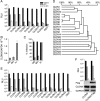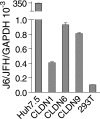Claudin-6 and claudin-9 function as additional coreceptors for hepatitis C virus
- PMID: 17804490
- PMCID: PMC2169001
- DOI: 10.1128/JVI.01457-07
Claudin-6 and claudin-9 function as additional coreceptors for hepatitis C virus
Abstract
Hepatitis C virus (HCV) is a global challenge to public health. Several factors have been proven to be critical for HCV entry, including the newly identified claudin-1 (CLDN1). However, the mechanism of HCV entry is still obscure. Presently, among the 20 members of the claudin family identified in humans so far, CLDN1 has been the only member shown to be necessary for HCV entry. Recently, we discovered that Bel7402, an HCV-permissive cell line, does not express CLDN1 but expresses other members of claudin family. Among these claudins, CLDN9 was able to mediate HCV entry just as efficiently as CLDN1. We then examined if other members of the claudin family could mediate entry. We show that CLDN6 and CLDN9, but not CLDN2, CLDN3, CLDN4, CLDN7, CLDN11, CLDN12, CLDN15, CLDN17, and CLDN23, were able to mediate the entry of HCV into target cells. We found that CLDN6 and CLDN9 are expressed in the liver, the primary site of HCV replication. We also showed that CLDN6 and CLDN9, but not CLDN1, are expressed in peripheral blood mononuclear cells, an additional site of HCV replication. Through sequence comparison and mutagenesis studies, we show that residues N38 and V45 in the first extracellular loop (EL1) of CLDN9 are necessary for HCV entry.
Figures





Similar articles
-
Isolate-dependent use of claudins for cell entry by hepatitis C virus.Hepatology. 2014 Jan;59(1):24-34. doi: 10.1002/hep.26567. Hepatology. 2014. PMID: 23775920
-
Selection of a hepatitis C virus with altered entry factor requirements reveals a genetic interaction between the E1 glycoprotein and claudins.Hepatology. 2015 Oct;62(4):1059-69. doi: 10.1002/hep.27815. Epub 2015 May 12. Hepatology. 2015. PMID: 25820616 Free PMC article.
-
Claudin-1 is a hepatitis C virus co-receptor required for a late step in entry.Nature. 2007 Apr 12;446(7137):801-5. doi: 10.1038/nature05654. Epub 2007 Feb 25. Nature. 2007. PMID: 17325668
-
Claudins and hepatocellular carcinoma.Biomed Pharmacother. 2024 Feb;171:116109. doi: 10.1016/j.biopha.2023.116109. Epub 2024 Jan 6. Biomed Pharmacother. 2024. PMID: 38185042 Review.
-
Claudin-1 and its potential role in HCV entry: another piece of the puzzle.J Clin Gastroenterol. 2008 Jan;42(1):3-4. doi: 10.1097/MCG.0b013e31814a4e7d. J Clin Gastroenterol. 2008. PMID: 18097281 Review. No abstract available.
Cited by
-
Use of Modified Clostridium perfringens Enterotoxin Fragments for Claudin Targeting in Liver and Skin Cells.Int J Mol Sci. 2019 Sep 26;20(19):4774. doi: 10.3390/ijms20194774. Int J Mol Sci. 2019. PMID: 31561440 Free PMC article.
-
The claudins.Genome Biol. 2009;10(8):235. doi: 10.1186/gb-2009-10-8-235. Epub 2009 Aug 26. Genome Biol. 2009. PMID: 19706201 Free PMC article. Review.
-
The SR-BI partner PDZK1 facilitates hepatitis C virus entry.PLoS Pathog. 2010 Oct 7;6(10):e1001130. doi: 10.1371/journal.ppat.1001130. PLoS Pathog. 2010. PMID: 20949066 Free PMC article.
-
Pseudotyped lentiviral vectors: Ready for translation into targeted cancer gene therapy?Genes Dis. 2022 Apr 2;10(5):1937-1955. doi: 10.1016/j.gendis.2022.03.007. eCollection 2023 Sep. Genes Dis. 2022. PMID: 37492721 Free PMC article. Review.
-
Hepatitis C Virus entry: the early steps in the viral replication cycle.Virol J. 2009 Jul 30;6:117. doi: 10.1186/1743-422X-6-117. Virol J. 2009. PMID: 19643019 Free PMC article. Review.
References
-
- Amoroso, P., M. Rapicetta, M. E. Tosti, A. Mele, E. Spada, S. Buonocore, G. Lettieri, P. Pierri, P. Chionne, A. R. Ciccaglione, and L. Sagliocca. 1998. Correlation between virus genotype and chronicity rate in acute hepatitis C. J. Hepatol. 28:939-944. - PubMed
-
- Bartosch, B., G. Verney, M. Dreux, P. Donot, Y. Morice, F. Penin, J. M. Pawlotsky, D. Lavillette, and F. L. Cosset. 2005. An interplay between hypervariable region 1 of the hepatitis C virus E2 glycoprotein, the scavenger receptor BI, and high-density lipoprotein promotes both enhancement of infection and protection against neutralizing antibodies. J. Virol. 79:8217-8229. - PMC - PubMed
-
- Blackard, J. T., N. Kemmer, and K. E. Sherman. 2006. Extrahepatic replication of HCV: insights into clinical manifestations and biological consequences. Hepatology 44:15-22. - PubMed
-
- Chen, R. M., D. H. Zhu, and X. Z. Ye. 1975. The establishment and character of human hepacarcinoma cell line (BEL-7402) in vitro. Comm. Sci. 20:434-436.
Publication types
MeSH terms
Substances
LinkOut - more resources
Full Text Sources
Other Literature Sources
Molecular Biology Databases

